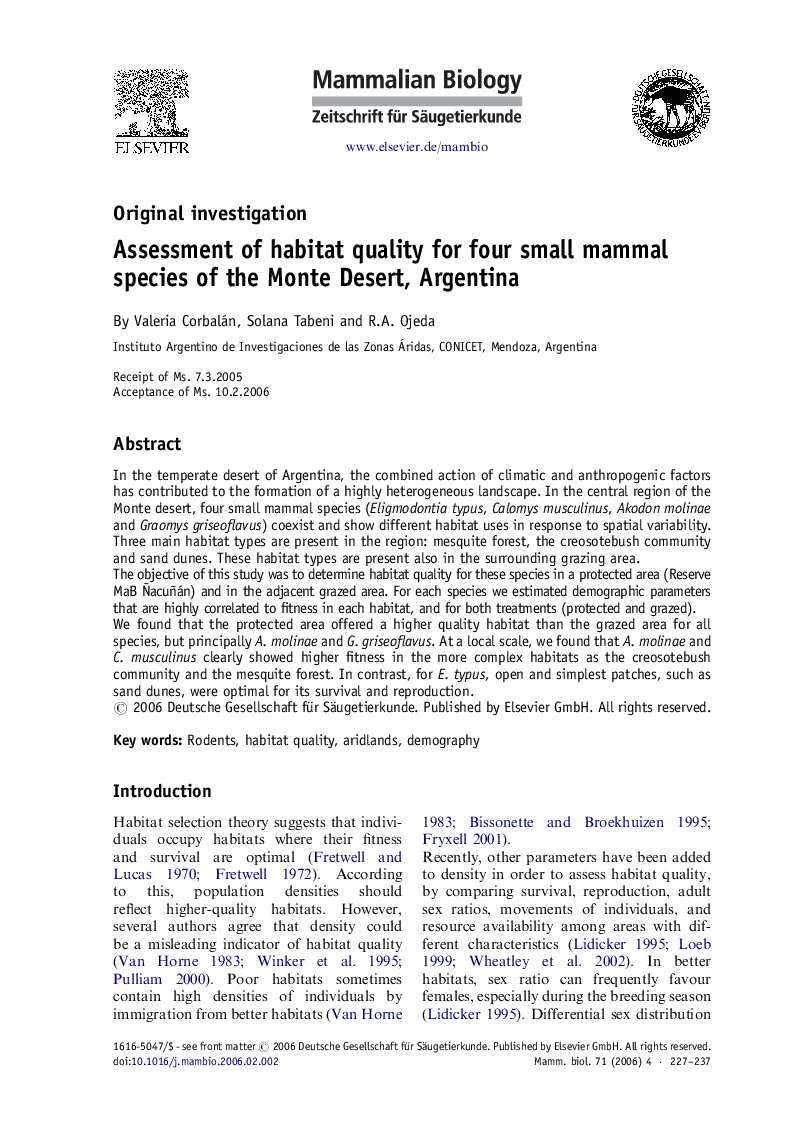| کد مقاله | کد نشریه | سال انتشار | مقاله انگلیسی | نسخه تمام متن |
|---|---|---|---|---|
| 2194342 | 1098433 | 2006 | 11 صفحه PDF | دانلود رایگان |

In the temperate desert of Argentina, the combined action of climatic and anthropogenic factors has contributed to the formation of a highly heterogeneous landscape. In the central region of the Monte desert, four small mammal species (Eligmodontia typus, Calomys musculinus, Akodon molinae and Graomys griseoflavus) coexist and show different habitat uses in response to spatial variability. Three main habitat types are present in the region: mesquite forest, the creosotebush community and sand dunes. These habitat types are present also in the surrounding grazing area.The objective of this study was to determine habitat quality for these species in a protected area (Reserve MaB Ñacuñán) and in the adjacent grazed area. For each species we estimated demographic parameters that are highly correlated to fitness in each habitat, and for both treatments (protected and grazed).We found that the protected area offered a higher quality habitat than the grazed area for all species, but principally A. molinae and G. griseoflavus. At a local scale, we found that A. molinae and C. musculinus clearly showed higher fitness in the more complex habitats as the creosotebush community and the mesquite forest. In contrast, for E. typus, open and simplest patches, such as sand dunes, were optimal for its survival and reproduction.
ZusammenfassungHabitatqualität für vier Kleinsäugerarten der Monte-Wüste, ArgentinienAufgrund klimatischer und menschlicher Einflüsse findet sich in den temperaten Wüsten von Südamerika ein vielfältiges Landschaftsmosaik. Im zentralen Teil der Monte-Wüste koexistieren vier Kleinsäugerarten (Eligmodontia typus, Calomys musculinus, Akodon molinae und Graomys griseoflavus), die aber unterschiedliche Habitatpräferenzen zeigen. Drei wichtige Habitattypen kommen im Untersuchungsgebiet vor: Mesquite-Gebüsch, Larrea-Gebüsch und Dünen.Die vorliegende Studie quantifiziert die Habitatqualität für die vier genannten Arten in einem Schutzgebiet (Reserve MAB Ñacuñán) sowie angrenzenden Weiden durch demographische Parameter. Diese Parameter korrelieren mit der Fitness im jeweiligen Habitat bzw. Nutzungstyp.Ganz allgemein zeigt das Schutzgebiet eine bessere Habitatqualität als die beweideten Flächen (insbesondere für A. molinae und G. griseoflavus). Lokal fanden wir eine größere Fitness von A. molinae und C. musculinus im Mesquite- und Larrea-Gebüsch als in der weit weniger komplexen Sanddüne. Für E. typus dagegen erwiesen sich die Sanddünen als optimales Habitat für Überleben und Reproduktion.
Journal: Mammalian Biology - Zeitschrift für Säugetierkunde - Volume 71, Issue 4, 22 July 2006, Pages 227–237